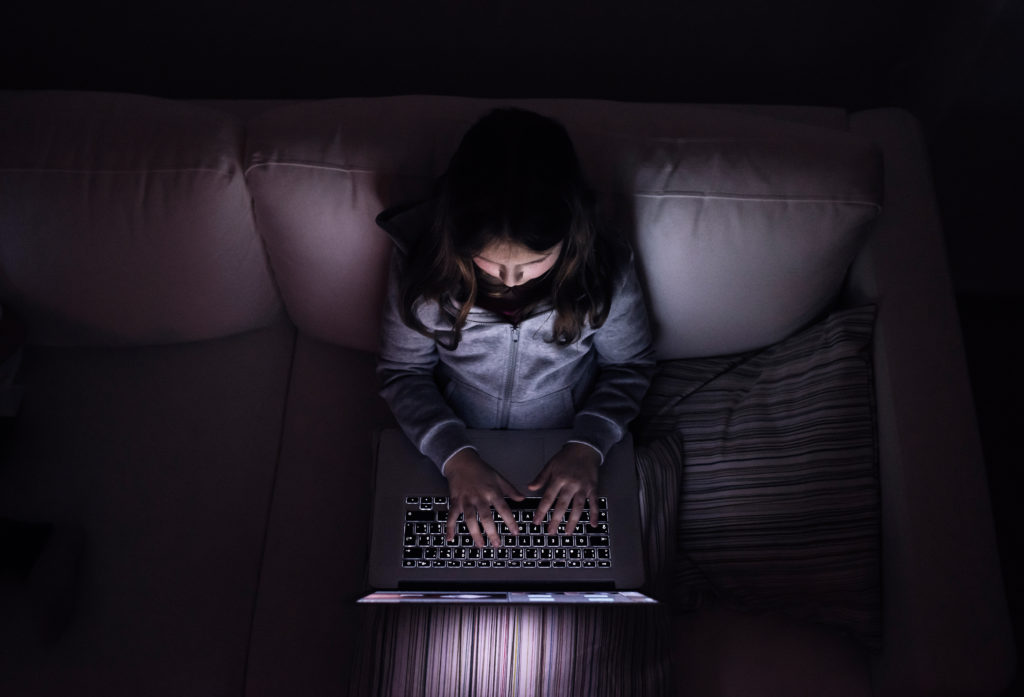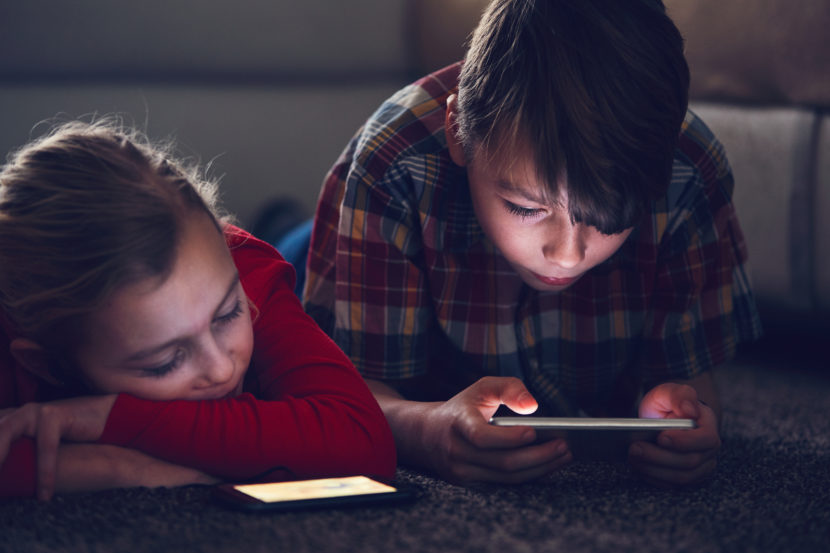The internet has the potential to broaden horizons and ignite creativity the world over, but with these opportunities come serious risks: cyberbullying, emotional abuse, grooming, sexual abuse and exploitation are some of the major risks which children may encounter every day all over the world. Raising awareness on this issue and promoting tools to detect some of these risks over time is the first step to promoting children’s right to protection and right of access to information.
What are the risks for children surfing the internet?
Children are spending more time online than ever before, and they’re getting there sooner. According to UNICEF, a child goes online for the first time every half second (UNICEF, 2023). In this sense, the internet offers limitless opportunities for children to learn, play, enter into contact with new people and develop their social networks. When used in the right way – and accessible to all – the internet has the potential to broaden horizons and ignite creativity the world over. But with these opportunities come serious risks (UNICEF, 2023).
The internet can be an enabler of different forms of online abuse, which is defined as any type of abuse that happens on the internet. It can happen online, or it can be part of other abuse which takes place offline, like bullying or grooming. Online abuse can be performed by strangers or by people known by the victim, and it can take place through different channels, including social media, text messages and messaging apps, emails, online chats, online gaming or live-streaming sites (NSPCC, 2023).
In this context, Child Sexual Abuse Material (CSAM) defines the imagery or videos which show a child engaged in or depicted as being engaged in explicit sexual activity (INHOPE, CSAM, 2023). CSAM can also be self-generated. In this sense, children can produce sexually explicit images portraying themselves intended for an age-appropriate relationship, but which can end up widely shared without consent (UNICEF, 2023).
Children and young people might experience different types of online abuse, such as:
- Cyberbullying: it is a violation of children’s rights. UNICEF defines cyberbullying as using electronic messages to harass, threaten, or target another person (UNESDOC, 2019). This form of online abuse is strictly linked to social media or instant messaging platforms. Unlike bullying that takes place offline, online bullying can follow the child wherever they go, and it can sometimes feel like there’s no escape or safe space (NSPCC, 2023). When browsing the internet, children may be exposed to hate speech and violent content – including messages that incite self-harm and even suicide (UNICEF, 2023).
- Emotional abuse: it encompasses any type of abuse that involves the continual emotional mistreatment of a child, and this can happen both on and offline.
- Grooming: the International Centre for Missing and Exploited Children (ICMEC) defines grooming as the process by which an adult builds a relationship with a child, to facilitate online or offline sexual contact (UNESDOC, 2019). Children and young people can be groomed online or face-to-face by a stranger or by someone they know (NSPCC, 2023).
- Sexual abuse: it is when a child or young person is forced or tricked into sexual activities. Sexual abuse can happen online – for example, a child could be forced to make, view or share child abuse images or videos or take part in sexual activities on conversations online.
- Sexual exploitation: it is a type of sexual abuse. It has never been easier for child sex offenders to contact their potential victims, share imagery and encourage others to commit offences. Children may be victimized through the production, distribution and consumption of sexual abuse material, or they may be groomed for sexual exploitation, with abusers attempting to meet them in person or exhort them for explicit content (UNICEF, 2023).
Child Sexual Abuse Material (CSAM) in numbers
According to work by the World Health Organization (WHO), every year 200 million children are sexually abused (UNESDOC, 2019). Much of this abuse either takes place online or is captured and digitally distributed. INTERPOL’s Child Sexual Exploitation database holds more than 1.5 million images and videos, collectively recording the abuse of more than 19,400 victims worldwide (UNESDOC, 2019). It is recognized that those numbers are only a small fraction of all the CSAM available, and that much remains undetected.

According to the Internet Watch Foundation (IWF), the victim is usually between 11 and 13 years (55%) or younger than 10 years (39%) (only 5% are 14-15 years old). Most of the CSAM material depicted girls (78%) whereas boys are represented only in 17% (4% depicted both sexes). Almost a quarter of all online CSAM in 2018 (23%) was of the severest kind, including images of rape and torture (Puddephatt, Hargreaves, 2019).
What should one do if a child reports online abuse?
Children and young people can disclose abuse at any time (AIFS, 2015) so it is important to know how to handle these kinds of disclosures. First, it is important to receive the disclosure without displaying shock or disbelief and take it seriously. The next step is to reassure the child that they did nothing wrong and that what they said is being seriously. Then, it is important to inform the child that this disclosure needs to be with other people, but only those whose job it is to protect children (British Council, 2023).
Since an allegation of child abuse may lead to a criminal investigation, nothing that may jeopardize a police investigation should be done. However, the child should be able to explain in their own words what happened without being asked any leading questions but only open questions. At last, it is beneficial for the listener to record the disclosure, that is, to make some very brief notes at the time and write them up in detail as soon as possible (British Council, 2023).
How to promote online safety in the future?
The internet is an incredible tool for children to learn, socialize and express themselves. Nevertheless, it is clear that it can also be an unsafe place for children. In fact, what happens online reflects the realities children face every day – at home, at school and in their wider communities, and it can lead to long-lasting effects on children.
This is the reason why to promote online safety for children, it is essential to involve all the actors involved in the life of a child, starting from the education sector in order to teach children digital-literacy and online-safety skills (UNICEF, 2023). The Covid-19 pandemic has proven the urgency of improving these skills and the inadequacy of the present education system to respond to these needs.
Governments have also a role in advocating and adopting all the necessary regulations, as well as tech companies have a duty in promoting the use of acceptable safety measures on their platforms (UNICEF, 2023). However, measures taken to protect children in the digital environment should not unduly restrict the exercise of other rights, such as the right to freedom of expression, the right to access information or the right to freedom of association (ITU, 2020). Governments should promote the use of the internet in preventing and addressing violence, such as the development of technologies and resources for children to access information, block harmful material and report instances of violence when they occur (ITU, 2020).
Moreover, governments should create a clear and predictable legal and regulatory environment which supports businesses and other third parties to meet their responsibilities to safeguard children’s rights throughout their operations, at home and abroad (BIK, 2020). In this sense, the European Strategy for a Better Internet for Children (the “Better Internet for Kids” or “BIK” Strategy) provides the primary overarching framework for policies regarding children’s online safety and empowerment when using digital technologies.
It brings together inputs from the European Commission, Member States and industry and it is aimed at delivering concrete solutions to problems encountered by children in the course of their online use, thereby bringing about a safer and better internet for children (BIK, 2020). In addition to the international and national framework, it is important to underline that all the people involved in the life of a child have an important role in their protection.
Parents, guardians, educators and all the people involved in the life of a child play a significant role in preventing and identifying some of the risks mentioned above. In this sense, it is important to detect the signs of online abuse, such as spending a lot more or a lot less time than usual online, texting, gaming or using social media; seeming distant, upset or angry after using the internet or texting, or be secretive about who they’re talking to and what they’re doing online or on their mobile phone (NSPCC, 2023).

Everyone has an important role in protecting a child from the risks of online abuse and promoting children’s right to protection and information. In this sense, Humanium is on the frontline in this common goal and through its work, it raises awareness of these issues as well as tries to promote tools and best practices. If you want to contribute to our cause, consider making a donation, volunteering or becoming a member.
Written by Arianna Braga
References:
AIFS (2015). Responding to children and young people’s disclosures of abuse. Retrieved from: https://aifs.gov.au/resources/practice-guides/responding-children-and-young-peoples-disclosures-abuse, accessed on 17 February 2023.
BIK (2020). The Third Better Internet for Kids Policy Map. Retrieved from: https://www.betterinternetforkids.eu/documents/167024/2637346/BIK+Policy+Map+2020+-+FINAL+for+publication+-+November+2020.pdf/2eb2c71f-c6b7-8e16-cbf8-224e52f9008a?t=1606326324655, accessed on 19 February 2023.
British Council (2023). Safeguarding under 18s. Retrieved from: https://www.britishcouncil.org/education/accreditation/information-centres/care-children, accessed on 17 February 2023.
INHOPE (2022). What is self-generated CSAM? Retrieved from: https://inhope.org/EN/articles/what-is-self-generated-csam#:~:text=Self%2Dgenerated%20Child%20Sexual%20Abuse,of%20online%20grooming%20or%20sextortion., accessed on 12 February 2023.
INHOPE, CSAM (2022). What is CSAM? Retrieved from: https://inhope.org/EN/articles/what-is-csam, accessed on 12 February 2023.
ITU (2020). Guidelines for Policy- makers. Retrieved from: https://www.itu-cop-guidelines.com/policymakers, accessed on 19 February 2023.
NSPCC (2023). What is child abuse. Retrieved from: https://www.nspcc.org.uk/what-is-child-abuse/types-of-abuse/online-abuse/, accessed on 12 February 2023.
Puddephatt, A. and Hargreaves, S. (2019). 2018 Annual Report. Retrieved from: https://www.iwf.org.uk/report/2018-annual-report, accessed on 12 February 2023.
UNESDOC (2019). Child online safety: minimizing the risk of violence, abuse and exploitation online, by Broadband Commission for Sustainable Development, International Telecommunication Union, UNESCO. Retrieved from: https://unesdoc.unesco.org/ark:/48223/pf0000374365.locale=en, accessed 12 February 2023.
UNICEF (2023). Protecting children online. Retrieved from: https://www.unicef.org/protection/violence-against-children-online, accessed on 12 February 2023.


